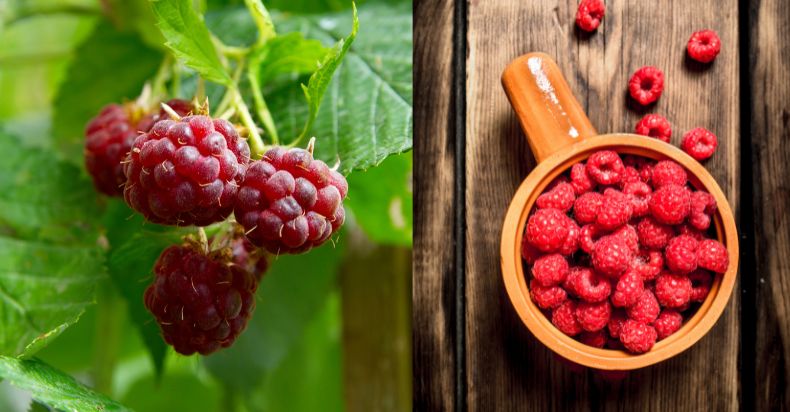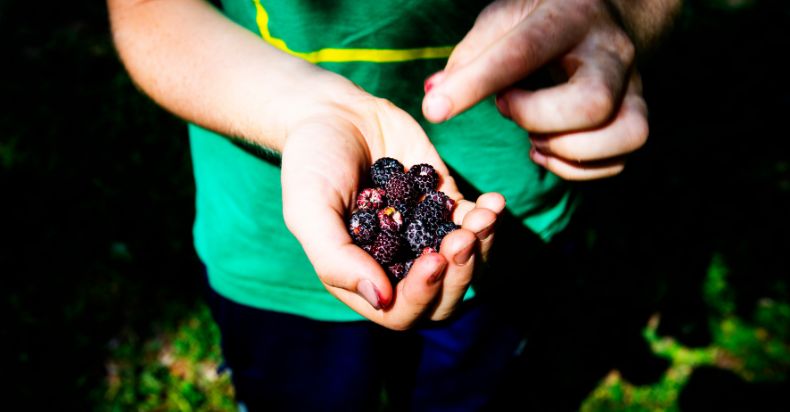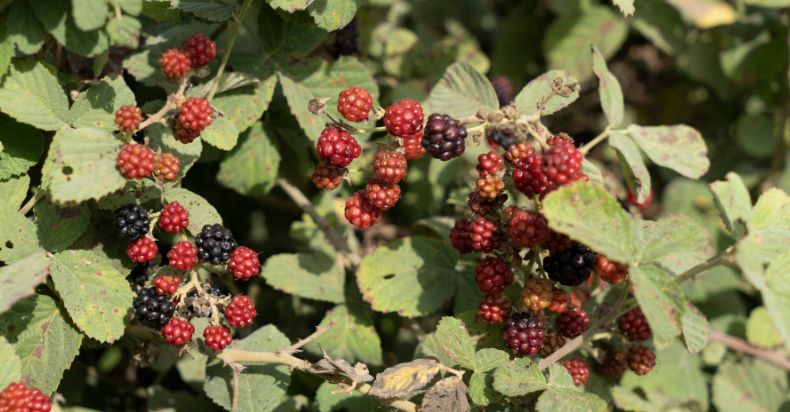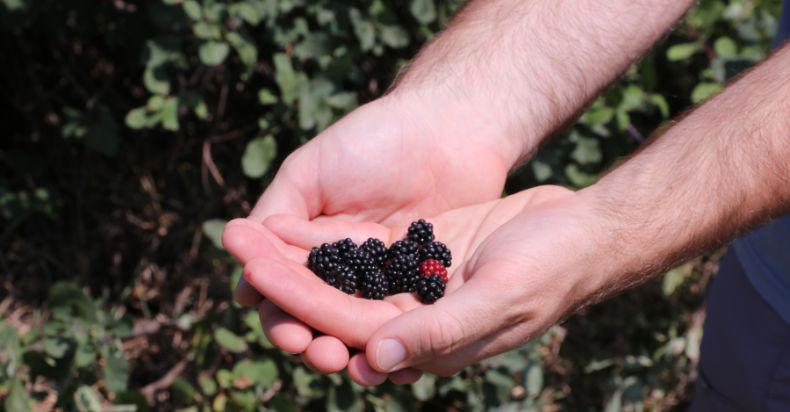Generally speaking, wild raspberries are safe to consume. They're not poisonous or harmful in themselves. However, like with any wild food, there are a few considerations to keep in mind to ensure your foraging doesn't lead to any unpleasant consequences.
When we talk about wild raspberries, we’re referring to those little red gems that grow without any human intervention. They’re the rebels of the berry world, sprouting up in forests, along hiking trails, and in meadows, completely at the mercy of Mother Nature.
Wild raspberries belong to the genus Rubus, which includes over 200 different species. These species can be found all over the world, from the chilly regions of Alaska to the sunny landscapes of Hawaii. So, no matter where you are, there’s a good chance you’re not too far from a wild raspberry bush!
The Difference Between Wild and Cultivated Raspberries

Now, let’s talk about the difference between wild and cultivated raspberries.
Cultivated raspberries are the ones you’re probably most familiar with. These are grown on farms, where they’re carefully tended to ensure they grow into the plump, juicy berries we love.
Farmers control their environment, providing the perfect amount of water, sunlight, and nutrients to help them grow. They’re also protected from pests and diseases, which can affect their growth and quality.
On the other hand, wild raspberries are left to fend for themselves.
They rely on natural rainfall for water, soak up whatever sunlight is available, and absorb nutrients from the soil they’re rooted in.
They’re also exposed to pests and diseases, which can affect their size and appearance.
Because of these differences, wild raspberries tend to be smaller than their cultivated counterparts. However, what they lack in size, they make up for in flavor.
Wild raspberries have a more intense flavor, which is often described as sweet yet tart. They're also more aromatic and have a firmer texture.
So, while they might not look as pretty as the raspberries you buy at the store, wild raspberries are a treat for the senses, offering a burst of flavor that’s hard to beat.
In the next section, we’ll discuss the safety of eating wild raspberries and how to avoid potential risks.
Are Wild Raspberries Safe to Eat?

So, we’ve established what wild raspberries are and how they differ from the cultivated ones. Now, let’s address the million-dollar question: are they safe to eat?
Yes, wild raspberries are safe to consume. They're not poisonous or harmful in themselves. However, like with any wild food, there are a few considerations to keep in mind to ensure your foraging doesn't lead to any unpleasant consequences.
Potential Risks and How to Avoid Them
One of the main risks associated with eating wild raspberries, or any wild food for that matter, is the potential for contamination.
Wild raspberries grow in the great outdoors, where they’re exposed to a variety of elements. They could be sprayed with pesticides or other chemicals if they’re growing near farmland or a garden.
They could also be contaminated by pollutants if they’re growing near a busy road.
To avoid these risks, it’s best to forage for wild raspberries in areas that are free from these potential contaminants. Look for raspberry bushes in forests, parks, or other natural areas that are away from heavy traffic and agricultural activities.
Another risk is the potential for illness caused by bacteria or parasites. This risk is relatively low, but it’s still worth considering.
To mitigate this risk, it’s a good idea to wash any wild raspberries you collect before eating them. This can help remove any dirt or tiny critters that might be hiding in the berries.
In the next section, we’ll discuss how to correctly identify wild raspberries to ensure you’re not accidentally picking and eating the wrong berries. Keep reading!
READ : Is It Safe to Eat Mushrooms With Brown Spots?
How To Identify The Right Wild Raspberries

Alright, so you’re ready to venture into the wild and forage for some raspberries. But wait! How do you make sure that the berries you’re about to pick are indeed raspberries and not some other berry that could potentially be harmful? Fear not, we’ve got you covered.
Identifying wild raspberries is relatively straightforward once you know what to look for.
Here are some key characteristics to help you spot the real deal:
- Color and Shape: Ripe wild raspberries are typically bright red, although there are some varieties that can be black or yellow. They have a round shape with a hollow center, which is a distinctive feature of raspberries.
- Leaves: Raspberry plants have compound leaves with three to seven leaflets. The leaflets are oval-shaped with serrated edges. They’re usually green on top and white or silvery on the bottom.
- Stems: Raspberry stems, also known as canes, are covered in small thorns. The canes can grow up to 6 feet tall and they typically bend over and touch the ground.
- Flowers and Fruits: Raspberry flowers are white and have five petals. The fruits (i.e., the raspberries) grow from these flowers.
Remember, if you’re ever unsure about whether a berry is a raspberry or not, it’s best to err on the side of caution and not eat it.
In the next section, we’ll explore the nutritional benefits of wild raspberries and why going wild can be good for you.
READ : Is It Safe To Eat Citrus With Black Spots?
The Nutritional Benefits of Wild Raspberries
Now that we’ve covered the safety aspects and identification of wild raspberries, let’s dive into the fun part – their nutritional benefits.
Spoiler alert: these tiny fruits are nutritional powerhouses!
Wild raspberries are packed with a variety of nutrients that can benefit your health in numerous ways.
Here’s a rundown of what these little berries have to offer:
- Vitamins: Wild raspberries are rich in vitamin C, a powerful antioxidant that boosts your immune system and helps protect your body against diseases. They also contain vitamin K, which is essential for blood clotting, and vitamin E, which supports skin health.[source]
- Minerals: These berries are a good source of manganese, a mineral that supports bone health and helps your body metabolize carbohydrates, amino acids, and cholesterol. They also contain smaller amounts of magnesium, iron, potassium, and calcium.
- Fiber: Raspberries are high in dietary fiber, which aids digestion and helps control blood sugar levels. A diet high in fiber can also help prevent heart disease, diabetes, weight gain, and some types of cancer.
- Antioxidants: Raspberries are loaded with antioxidants, which are substances that help protect your cells against free radicals. Free radicals are harmful molecules that can damage cells and contribute to aging and diseases.
- Low in Calories: Despite their sweet taste, raspberries are low in calories, making them a great choice for those watching their weight.
So, not only are wild raspberries a tasty treat, but they’re also a great way to boost your nutrient intake.
In the next section, we’ll discuss how to harvest and store wild raspberries to make the most of your berry bounty. Keep reading!
READ : Is It Safe To Eat Pomegranate Skin?
How to Harvest and Store Wild Raspberries?

You’ve identified the wild raspberries, you’re aware of their nutritional benefits, and you’re ready to start picking.
But hold on a second! There’s a right way and a wrong way to go about this. Let’s ensure you’re equipped with the knowledge to do it correctly.
Harvesting wild raspberries is a delicate process. These berries are quite fragile and can easily be squished if you’re not careful.
Here are some tips to help you harvest wild raspberries:
- Gentle Touch: When picking the berries, be gentle and use your fingers to lightly twist the berry off the stem. If the berry is ripe, it should come off easily.
- Timing: The best time to pick wild raspberries is in the morning after the dew has dried but before the afternoon heat sets in. This helps ensure the berries are at their freshest.
- Container: Use a shallow container to collect the berries. Piling raspberries in a deep container can cause the ones at the bottom to get squished.
Now that you’ve harvested your wild raspberries, it’s important to store them properly to maintain their quality. Here’s how:
- Don’t Wash Right Away: Resist the urge to wash the berries as soon as you get home. The moisture can cause them to spoil faster. Instead, wait to wash them until right before you’re ready to eat or use them.
- Refrigeration: Store the raspberries in the refrigerator if you plan on eating them within a couple of days. Place them in a single layer on a plate or shallow container lined with a paper towel to absorb any excess moisture.
- Freezing: If you’ve harvested more raspberries than you can eat in a few days, freezing them is a great option. To freeze raspberries, spread them out in a single layer on a baking sheet and place them in the freezer. Once they’re fully frozen, you can transfer them to a freezer bag or container. They’ll keep in the freezer for up to one year.
Verdict: To Eat or Not to Eat Wild Raspberries?
So, we’ve journeyed through the world of wild raspberries, from understanding what they are, identifying them, knowing their nutritional benefits, to learning how to harvest and store them.
The verdict? Wild raspberries are not only safe to eat but also a delightful treat that nature has to offer.
However, remember to forage responsibly. Ensure the area is clean and free from pollutants, and always wash the berries before consumption. Happy foraging, and enjoy the fruits of your labor!
FAQs
Are wild raspberries poisonous?
No, wild raspberries are not poisonous.
However, it’s important to correctly identify them to avoid consuming other potentially harmful berries.
Can I eat wild raspberries raw?
Yes, you can eat wild raspberries raw. They’re delicious as they are, but you can also use them in cooking or baking.
How can I tell if a wild raspberry is ripe?
A ripe wild raspberry will be bright red and come off the stem easily when picked.
Can I freeze wild raspberries?
Yes, you can freeze wild raspberries. Just spread them out on a baking sheet to freeze individually before transferring them to a freezer bag.
Are wild raspberries as nutritious as cultivated ones?
Yes, wild raspberries are just as nutritious as cultivated ones, if not more so.
They’re packed with vitamins, antioxidants, and fiber.
